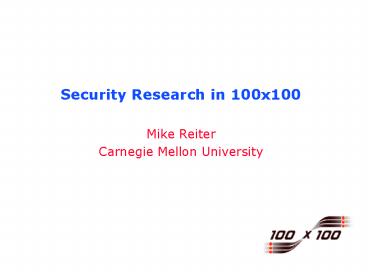Security Research in 100x100 - PowerPoint PPT Presentation
1 / 21
Title:
Security Research in 100x100
Description:
Is it possible to identify the worm origin without any a priori knowledge about the attack? ... Worm source. Ed Knightly. Ongoing Prototyping Effort ... – PowerPoint PPT presentation
Number of Views:30
Avg rating:3.0/5.0
Title: Security Research in 100x100
1
Security Research in 100x100
- Mike Reiter
- Carnegie Mellon University
2
A Clean Slate Design
- Many fundamental questions to consider, e.g.
- Should source authentication be intrinsic (or
eschewed) in 100x100? - Should the network support anonymous /
pseudonymous access? - Should connectivity be the default?
- What auditing capabilities should be present?
- What is the interaction between addressing and
security?
3
Our Initial Work Sekar, Xie, Maltz, Reiter,
Zhang
- Thesis A framework for forensic analysis is
fundamental for future networks - Initial demonstration primarily focused on
attacks that exploit the scale of the network - Epidemic attacks
- Though contemplated for future networks, also
have an eye toward todays Internet - Realistically, deployment would be incremental
- May have additional applications, as well
4
The Structure of Attacks
Attackers
Involved hosts (e.g., zombies)
Identified Victims
Worm Infection
Distributed DoS
- Modern attacks are multi-level
- Large scale difficult to defend
- Hidden trail difficult to identify initial
launch point
5
Our Position
- A fundamental capability --- network auditing and
forensic analysis - Keep communication records
- Permit post-mortem analysis of patterns across
network and time - Scope Internet and intranet
- Correct weak points in a network perimeter
- Deter future similar attacks
6
Two Applications
t4
t1
t3
B
F
E
t7
t2
t5
H
D
C
t6
G
- Attack Reconstruction infer which communication
carry the attack forward - Attacker Identification pinpoint the attack
source(s)
7
Power of Network Auditing/Forensic
- Attackers and victims must communicate for the
attack to propagate - Independent of attacks
- Visible to the network
- Globally analyze communication events
- General across a wide range of attacks
- Applicable to different attack propagation speeds
- Possible with/without attack signature
8
Worm Origin Identification
- Future worm attacks
- Different time scales seconds, hours, days
- Various security exploits
- Different propagating methods random scan,
- hit list scan
- Is it possible to identify the worm origin
without any a priori knowledge about the attack?
9
A Graph Representation
- A directed host contact graph G ltV, Egt
- V H x T (H the set of all hosts, T time)
- e ? E a network flow ltsource, destination,
start-time, end-timegt - Assumption flow directionality consistent with
causality
- Normal edge
- Causal edge
- flows infect destinations
- successfully
- Non-causal attack edge
- failed infection attempts
- with infectious payload
J
I
H
G
F
E
D
C
T
10
Problem Formulation
- Input an unlabeled directed host contact graph G
- Desired output label causal edges initial in time
J
I
H
G
?
F
E
D
C
Causal tree
T
11
Accuracy of Realistic Algorithms
- False positives
- Non-causal attack edges and normal edges
- False negatives
- Causal edges that are not identified
Input
J
I
H
G
F
E
D
C
T
12
Random Moonwalks
- A random moonwalk on the host contact graph
- Start with an arbitrarily chosen flow
- Pick a next step flow randomly to walk backward
in time - Observation epidemic attacks have a tree
structure - Initial causal flows emerge as high frequency
flows
J
- Parameters
- d maximum path length
- ?t sampling window size
I
H
G
F
E
D
45
C
T
13
The Sampling Process
- Each random moonwalk
- A sample of path into the history
- Given a network trace
- Step 1 Select sampling parameters
- Chosen based on the given trace
- Step 2 Perform moonwalks repeatedly
- Update the count of each edge being traversed
Step 3 Output Z highest frequency edges
14
Intuition
- Each walk samples a potential causal chain of
events - High frequency edges are indirectly responsible
for a large number of edges - Normal host contact graphs are sparse
- Incoming flows to normal hosts are likely
suspicious - Direct walks to infected hosts
- More edges lead to infected hosts than edges lead
away - Sending attack traffic increases the rate of
outgoing flows - Concentrate walks backward to the attack origin
15
Real Trace Evaluation
- Is random moonwalk effective for slow
- attacks with real background
traffic? - Data CMU campus backbone trace
- 1.4 million flows over 4 hour period, 8040 campus
hosts - Worm flow injection
- 10 of vulnerable hosts, 1 attack flow per t
seconds (t 2 10, 100) - 90th normal flow rate 1 flow per 20 seconds
- Detection accuracy
- Target_flows / selected_flows after 104 walks
16
Detect the Existence of an Attack
17
Identify the Initial Causal Flows
- High accuracy with a small number of walks
- Note total 804 causal flows from 1.52 million
flows - Majority of identified causal edges are initial
ones
18
Structure of the Selected Flows
Worm source
- Top Frequency Flows display a tree-like structure
19
Ongoing Prototyping Effort
- Collaboration with CMU campus network
- Phase 1 Flow-level Argus trace at campus
backbone (done) - Phase 2 Enhanced traffic monitoring system
(ongoing) - Phase 3 Real time attack detection and
reconstruction (in near future) - Collaboration with Internet2
- Deployment of dragnet at large educational
backbones - Goal A framework of attack investigation based
on multiple network monitors and views
20
Toward 100x100
- One possibility for the 100x100 is a regular mesh
structure - This may substantially simplify where monitors
are placed - Placement in todays networks is a topic of
ongoing research
21
Other Work
- Analysis of the predictive value of traffic
Collins, Reiter - Multi-resolution detection of worm propagation
Sekar, Xie, Maltz, Reiter, Zhang































